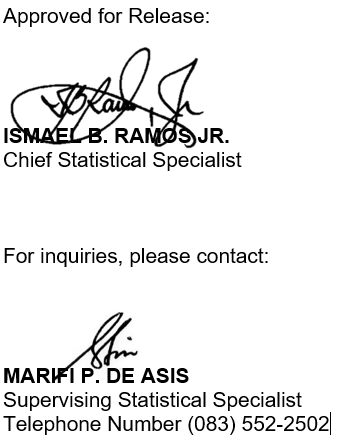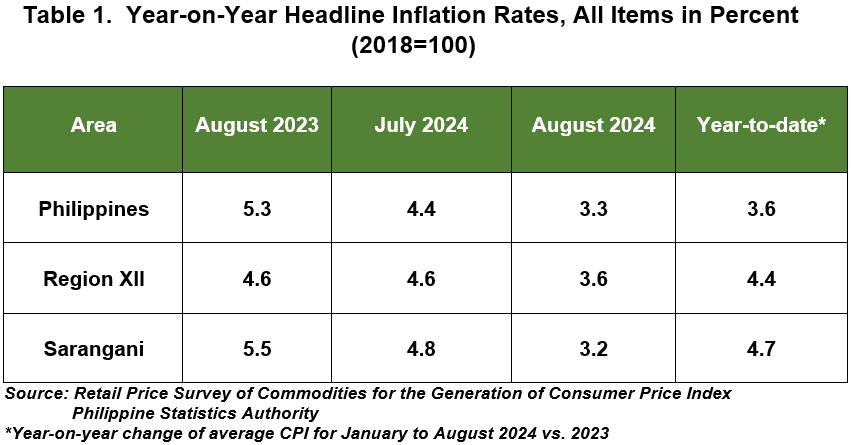
YEAR-ON-YEAR INFLATION RATES
The headline inflation in Sarangani decreased to 3.2 percent in August 2024 from 4.8 percent in July 2024. This was lower than the regional and national levels at 3.6 percent and 3.3 percent, respectively. In August 2023, the inflation rate was higher at 5.5 percent. From January to August 2024, the provincial average inflation was 4.7 percent. (Table 1 and Figure 1).

The decrease in the province’s inflation rate in August 2024 was primarily influenced by the slower annual increment of food and non-alcoholic beverages at 4.5 percent from 7.0 percent inflation in July 2024. This was followed by transport at -0.4 percent in August 2024 from 5.0 percent in July 2024. The index of personal care, and miscellaneous also contributed to the downtrend with an inflation rate of 3.1 percent during the month from 3.9 percent in July 2024.
Additionally, the following commodity groups noted lower annual increment during the month:
a. Clothing and footwear, 0.2 percent from 0.3 percent;
b. Furnishings, household equipment and routine household maintenance, 0.7 percent from 1.1 percent;
c. Health, 3.2 percent from 3.7 percent; and
d. Recreation, sport and culture, 6.5 percent from 7.3 percent. (Table 2)
On the contrary, the following commodity groups registered higher annual increments during the month:
a. Alcoholic beverages and tobacco, 3.0 percent from 2.9 percent; and
b. Housing, Water, Electricity, Gas and Other Fuels, 3.4 percent from 2.5 percent. (Table 2)
The following are the commodity groups that retained their previous month’s annual rates:
a. Information and communication, at 0.1 percent;
b. Education services, at zero percent;
c. Restaurants and accommodation services, at zero percent; and
d. Financial services, at zero percent. (Table 2)
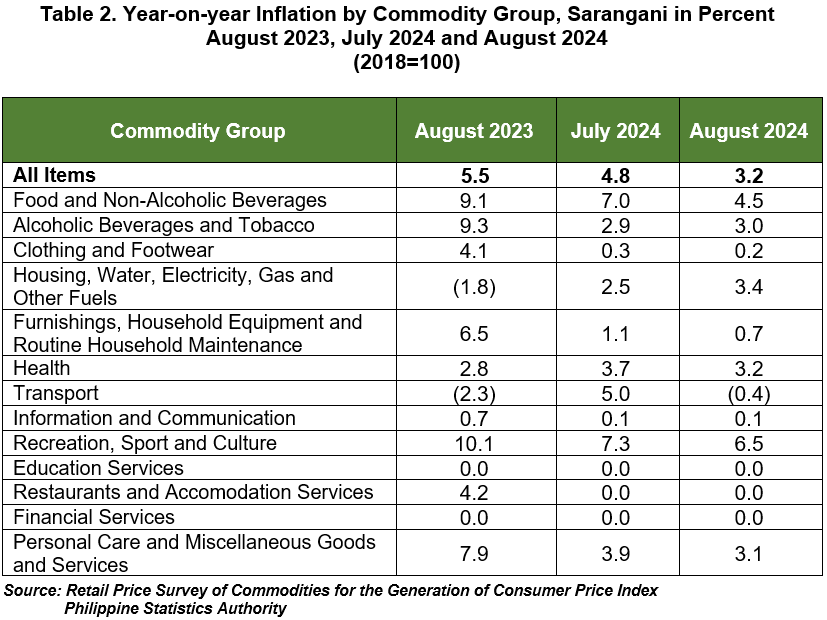
The drop of inflation rate for food and non-alcoholic beverages was primarily due to the slower annual growth in the cereals and cereal products index at 11.7 percent in August 2024 from 17.3 percent in July 2024.
The following indices also contributed to the lower annual increment during the month:
a. Vegetables, tubers, plantains, cooking bananas and pulse, 0.9 percent from 10.4 percent;
b. Fish and other seafood index, -5.5 percent from -4.0 percent.
c. Ready-made food and other food products n.e.c., 7.4 percent from 9.9 percent;
d. Sugar, confectionery and desserts, -10.2 percent from -9.8 percent; and
e. Fruit and vegetable juices, 0.0 percent from 0.5 percent; and
f. Other non-alcoholic beverages, 1.0 percent from 3.0 percent. (Table 3)

Food inflation at the provincial level slowed down to 4.7 percent in August 2024 from 7.3 percent in July 2024. In August 2023, food inflation was higher at 9.3 percent. (Table 4)
The deceleration of food inflation in August 2024 was due to the slower annual increase in cereals and cereal products with 11.7 percent from 17.3 percent in July 2024. Particularly, rice decreased from 24.7 percent to 15.7 percent in August 2024. (Table 4)
Slower annual increments were also noted in the indices of the following food groups during the month:
a. Flour, bread and other bakery products, pasta products, and other cereals, 0.6 percent from 7.0 percent;
b. Vegetables, tubers, plantains, cooking bananas, and pulses, 0.9 percent from 10.4 percent;
c. Fish and other seafood, -5.5 percent from -4.0 percent;
d. Ready-made food and other food products n.e.c., 7.4 percent from 9.9 percent; and
e. Sugar, confectionery and desserts, -10.2 percent from -9.8 percent. (Table 4)
In contrast, higher annual growth rates during the month were recorded in the indices of the following food groups:
a. Meat and other parts of slaughtered land animals, 2.0 percent from 0.1 percent;
b. Milk, other dairy products, and eggs, 5.6 percent from 2.7 percent;
c. Oils and fats, 3.9 percent from 1.3 percent; and
d. Fruits and nuts, 10.4 percent from 6.2 percent. (Table 4)
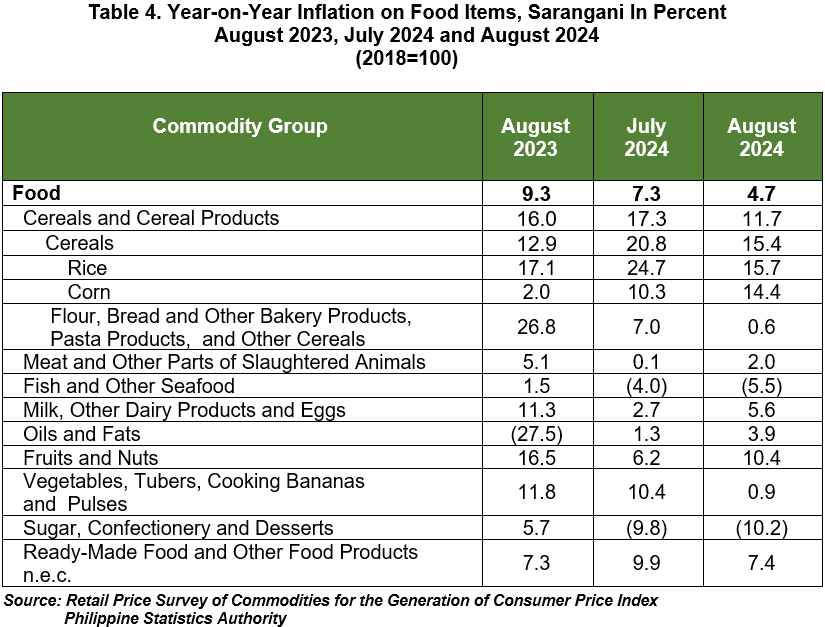
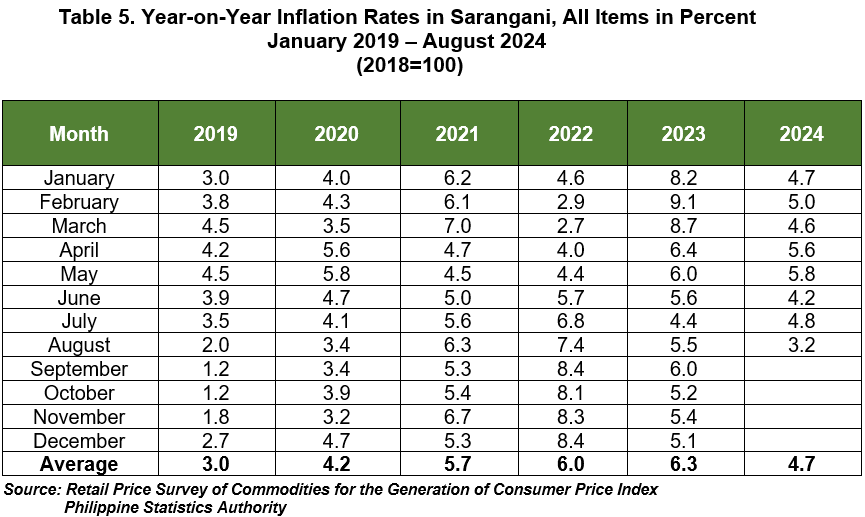
Definition of Terms
Base Period/Year this refers to the period, usually a year, at which the index number/points is set to 100. It is the point of index number series.
Consumer Price Index the average retail prices of a fixed basket of goods and services commonly purchased by households relative to a base year
Headline Inflation measure changes in the cost of living based on movements in the prices of a specified basket of major commodities. It refers to the annual rate of change or the year-on-year change in the CPI.
Inflation Rate the annual rate of change or year-on-year change in the CPI expressed in percent
Market Basket refers to a sample of goods and services that are commonly purchase and bought by an average Filipino household
Weights a system that considers the relevance of the components of the index
